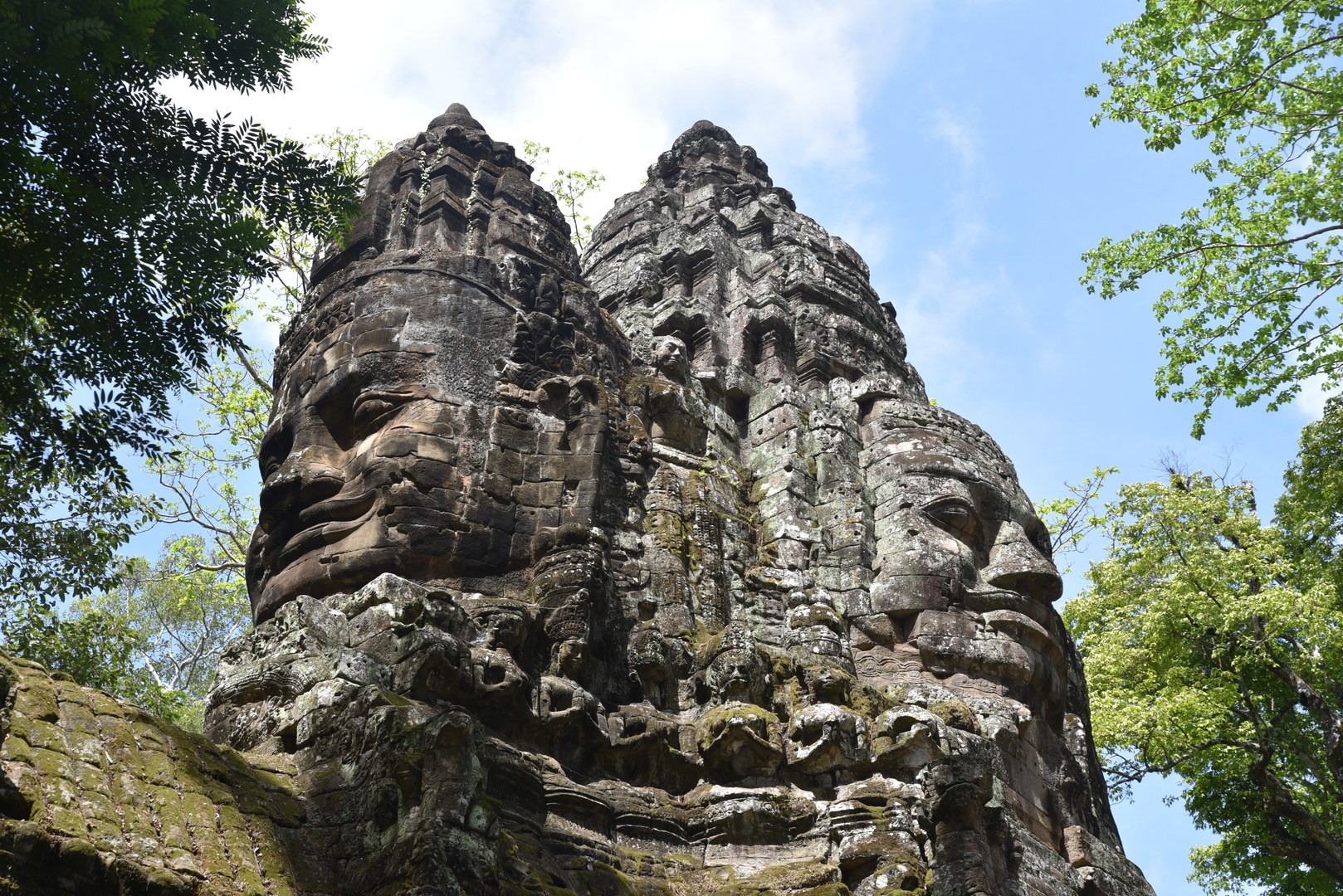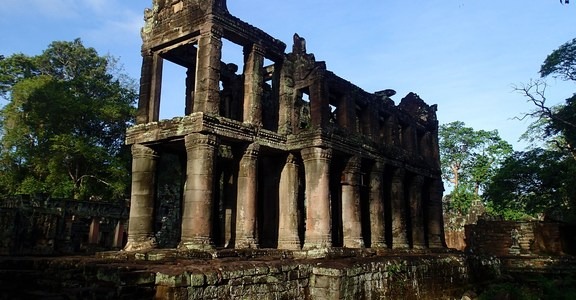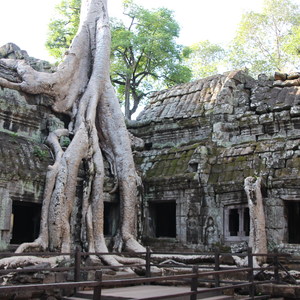You are here
Angkor Thom is the center of Angkor Aerchaeological Park and often over shadowed by it's neighbor, Angkor Wat. Angkor Thom is a conglomeration of various temples, each with it's own purpose. Angkor Thom is surrounded by a moat and then a wall with five gates that give access to the temple area. However, only the South, West, North and Victory gates are active for entry.
Before you go, make arrangements through your hotel to hire a tuk-tuk driver to take you around the sites. It is very affordable, usually within a range of $15 to $20 U.S. dollars for the day. Next, purchase your park entry pass, which come as single day tickets, three-day tickets, or seven-day tickets.
It is best to start this adventure through the South Gate of Angkor Thom. All temples within Angkor Thom open at 7:30 a.m. The South Gate is an impressive feature, escpecially early in the morning. You can access this as early as you like because it is not considered a temple, and it is worth the effort to see the gate with no one passing through it.
The first temple you come across in Angkor Thom is Bayon. Bayon is known for the 200 faces of Buddha. While there are not 200 faces now due to erosion and the collapse of parts of the structure, it is still impressive. Hours can be spent exploring the different angles of the Buddha faces, the Hall of the Dancing Apsaras, and the impressive bas-reliefs that tell the story of the Khmer people during the 12th century. While you can arrive at Bayon before 7:30 a.m., but won't be able to enter until then, and the temple gets crowded after 9:00 a.m. If you are into photography, enter at 7:30 a.m. Another good option is to stop back here at around 4 p.m. Most tourist are gone by then, and you might have the temple mostly to yourself.
After Bayon, it is a short drive to the heart of Angkor Thom, the palace area. While the palace no longer exists, much of the temples are in excellent condition. The first temple is this area is Baphuon. Baphuon is situated just northwest of Bayon Temple. It was built in the 11th century and was initially a Hindu temple, but by the 15th century it was converted into a Buddhist temple. Baphuon was built upon a sand base. Because of this, it suffered many collapses over hundreds of years. A major restoration project started in 2005 by French archeologists, and the job was completed in 2011 with a ceremony that included the King of Cambodia and the Prime Minister of France. Baphuon's long walkway to the front of the structure is truly impressive. There is a social trail that circles the complex, and you can also access the top by steep steps. At the top and around the back is an interesting and partially exposed hallway that provides excellent photographic opportunities.
Behind Baphuon is a trail that leads through the palace wall by way of a small, interesting stone gate. Follow the trail for a short distance until you reach the next temple, Phimeanakas. Phimeanakas is a three-tiered temple constructed in the 10th century. The original structure had a tower on top that has since collapsed and not been reconstructed.
Continue past Phimeanakas after some different views and follow a trail to the Royal Ponds known as Sras Srei. The ponds have steps leading into the water, but swimming is not permitted. After Sras Srei you can follow a trail through the palace wall and another gate. Continue on the trail until you reach another temple called Preah Palilay.
If Angkor Thom is your first stop when exploring the park, Preah Palilay will be you first opportunity to see how the jungle started to take over the structures of Angkor. The main temple, while small, has a prominant tree growing from one of the tiers. After some exploring of the Preah Palilay area, walk back out to the road you have been paralleling. Across the road are some roadside food options as well as tourist trap vending stalls. Stall number 23 has the best breakfast and is popular with the tuk-tuk drivers.
To conitunue the explorartion of Angkor Thom, you can work your way back along this east side atop two terraces. The first is the Terrace of the Leper King. The Buddha statue on top is not original. Below the terrace is a maze of sorts with a narrow passage. It is definitely worth walking this passage to view the thousands of carved Buddhas. You can then get back on the terrace and walk north. When you reach the terrace causeway, you will be on the Terrace of the Elephants. You will also see an impressive gate house leading back to the Royal Palace grounds. Continue north, but be sure to step on the terrace toward the road and view the carved elephants on the wall of the terrace as well as the elephant trunk columns beside the steps of each access point to the terrace. While walking along the terrace you will be able to see the Prasat Suor Prat.
After reaching the end of the Terrace of the Elephants, you can cross the road and follow a trail to have a closer look at Prasat Suor Prat. There are 12 towers in varying states of repair. This trail will take you back to the food stalls, but before reaching them and just behind the food stalls is one of the least explored ruins in Angkor Thom known as Preah Pithu Group. There are many small structures here to explore by way of several paths.
Much of this is typically done as part of the Small Circuit Tour, where you will exit Angkor Thom by way of the Victory Gate. You can have your tuk-tuk driver wait at the food stalls after dropping you off at Baphuon.








Comments
Sign In and share them.